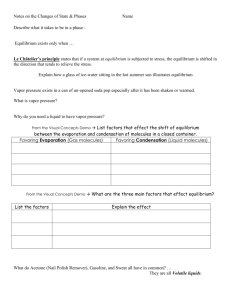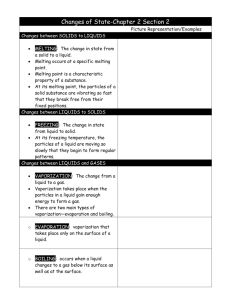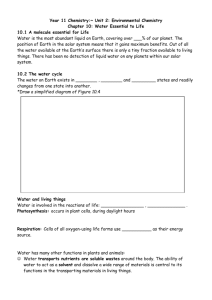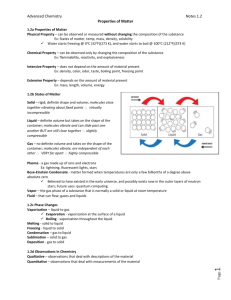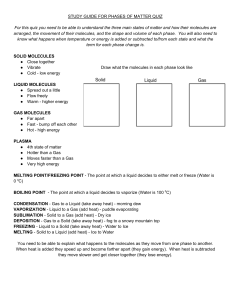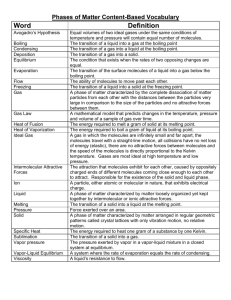States of Matter
advertisement
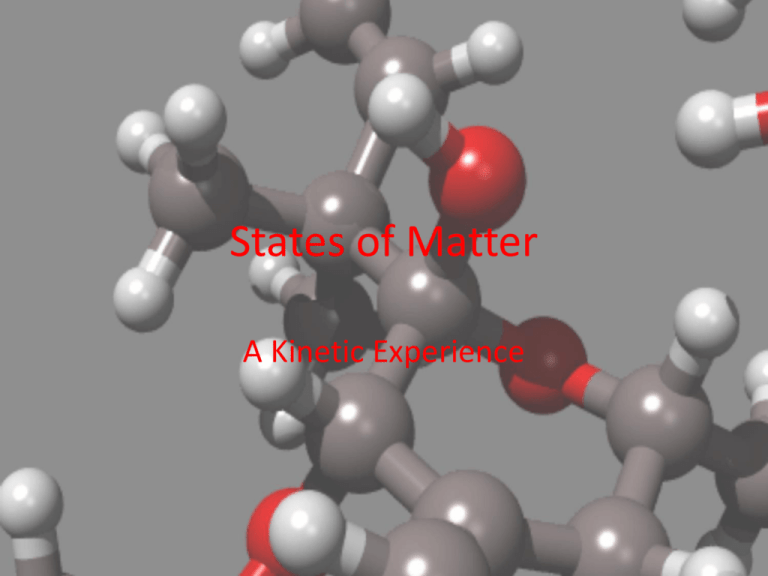
States of Matter A Kinetic Experience Kinetic Theory of Matter Also known as the Molecular theory of matter: • All matter is made of molecules and atoms that act like tiny particles • Molecules are always in motion. The higher the temperature, the faster the particles move • At the same temperature, heavier particles move slower than lighter particles. Solid, Liquid, Gas Balls in Box Demo • Small vibrations = Solid • More Energy Added in the form of heat energy, bouncing inside box = Liquid • Even More Energy Added in the form of heat energy, balls falling out of box = Gas (evaporation) Heavier molecules evaporate at a slower rate. • Putting the balls back into the box = Condensation Why metal balls inside some of the tennis balls? • Heavier molecules take more energy to evaporate. • Lighter molecules evaporate more readily. • Video – Kinetic Molecular Theory Watch as the water molecules gain enough kinetic energy to evaporate. How does thermal energy affect the state of a substance? • Thermal Energy interactive Video – Investigate at home • Video molecules in motion Amazing Ice Melting Blocks • http://www.youtube.com/watch?v=v qDbMEdLiCs&feature=c4-overviewvl&list=PL772556F1EFC4D01C Amazing Ice Melting Blocks • Oh, my the way, The “cold” block and the “warm” block are both the same temperature, namely room temperature. • What did you notice? 1. Things at the same temperature can feel as though they are at different temperatures. 2. The ice on the two blocks melts at extremely different rates, in a way that is completely unexpected. Amazing Ice Melting Blocks What’s happening? The “cold” Block The “warm” block • Made of Al • High heat conductivity • Feels cold because it is rapidly conducting heat from your hand • Cools your hand much more than expected so your brain tells you the block is cold. • Made of Plastic Foam • Poor conductor of heat. (Due to gas bubbles in it) • Feels warm because heat is conducted more slowly from your hand • Warmer to your hand than what is expected so your brain tells you the block is warm. Amazing Ice Melting Blocks What’s happening? So if they are both at room temperature why did one melt the ice faster? Ice must have heat energy transferred to it before it will melt. • The high heat conductivity of the Al block allows it to conduct heat rapidly to the ice- resulting in a rapid melting. Temperature • Temperature is the average kinetic energy of the atoms (or molecules) in a system. Temperature measures how “hot” something is. Temperature Scales • Fahrenheit English system – Water freezes at 32 degrees Fahrenheit and boils at 212 degrees. • Celsius modern system – freezing point of water 0 degrees Celsius, and the boiling point 100 degrees Celsius. • Kelvin A scale that is based on energy content . – At zero Kelvin (absolute zero) all molecular motion stops. – Scientists have figured out a way to get a temperature only a few billionths of a degree above absolute zero. 5 States of Matter • Elements and compounds can move from one phase to another when specific physical conditions are present. • When the temperature of a system goes up, the matter in the system becomes more excited and active. • As the temperature rises, matter moves to a more active state. 5 States of Matter • • • • • • Bose-Einstein Condensates (BEC) Solids Liquids Gases Plasmas Each of these states is also known as a phase. What is a Condensate? Think Condensation • Condensation happens when several gas molecules come together and form a liquid. The molecules get denser or packed closer together. • It all happens because of a loss of energy. Gases are really excited atoms. When they lose energy, they slow down and begin to collect. • Water (H2O) vapor in the form of steam condenses on the lid of your pot when you boil water. It cools on the metal and becomes a liquid again. You would then have a condensate. What is a solid? • Solids have a – definite shape – definite volume. – Molecules are tightly packed – Cannot move freely, can only vibrate – Molecules stay fairly still. – Energy and temperature are very low Types of Solid Crystalline Solids- Repeating pattern ex. Ghost crystals, crystals in rocks, salt, rock candy Amorphous Solids- - Non-repeating pattern ex. Wax, play dough, hand putty, peanut butter, gum, clay DRAW A SOLID. What is a liquid? Liquids have • no definite shape, take shape of container in which it is held • Definite or fixed volume. • Molecules are closely packed • Molecules vibrate and slide around one another easily. • Energy and temperature, in comparison to a solid, are higher • The force of attraction between these particles is called intermolecular forces. These force cause liquid particles to be fairly close together, thus raising the density of a liquid compared to a gas. A misconception that molecules do not touch in a liquid. Demo Examples: Water in different sized containers. Water in syringe Water in baggie. DRAW A LIQUID. Solid/LiquidCheck-Up 1. Describe particle motion in a solid. 2. Describe particle motion in a liquid. 3. What are two different types of solids? Give 1 example of each. 4. What is a common misconception about liquids? What is a Gas? • Gases have indefinite and unstable shape • No definite volume, volume determined by container • Molecules can vibrate, slide, spin, and bounce off of one another. • Molecules are far apart and can move around quickly. • Energy and temperature are the higher than those of both solids and liquids • Gases diffuse (The movement of particles from a region of high concentration to a region of low concentration) . • Heat will increase the rate of diffusion. Examples: Perfume “tooting your little horn” Lysol Ammonia Did you know that Gases were also called fluids? Why? DRAW A GAS. Vapor vs. Gas • Vapor and gas mean the same thing. • The word vapor is used to describe gases that are usually found as liquids. • Good examples are water (H2O) or mercury (Hg). Water and mercury are liquids at room temperature, so they get the vapor title when they are in a gaseous phase. • Compounds like carbon dioxide (CO2) are usually gases at room temperature, so scientists will rarely talk about carbon dioxide vapor. Water Vapor from a geyser Compressed Gases With very little pressure, gas molecules can be compressed. Examples – compressed air in a spray bottle – When you feel the carbon dioxide rush out of a can of soda. • These gas were forced into a smaller space so the gas escapes the first chance it gets. • The gas molecules move from an area of high pressure to one of low pressure. What is plasma? • • • Charged particles --Ionized Gas-- a cloud of protons, neutrons and electrons where all the electrons have come loose from the atoms This is an extreme gas! Strikes the other atoms so forcefully it knocks off an electron! These gases – vibrate, – Slam into one another causing bright gases, – lots of heat – lots of energy. • Hotter than gas. A plasma occurs when the temperature is between 1000 degrees C and 1,000,000,000 degrees C Neon Signs Plasma Examples Our Sun, the core of stars Lightning Plasma TV Aurora Borealis plasma balls Plasma Cutters Human Christmas Tree DRAW PLASMA. Plasma the 4th State of Matter Gas/Plasma Check-Up 1. 2. 3. 4. Describe particle motion in a gas. Describe particle motion in plasma. What is another name for plasma? How is plasma formed? A Phase Change • A "phase" describes a physical state of matter. • The key word to notice is physical. – If energy is added (like increasing the temperature) or if energy is taken away (like freezing something), you have created a physical change. A Phase Change • A compound or element can move from one phase to another, but still be the same substance. • It may require extreme temperatures or extreme pressures, but it can be done. Melting or Fusion • The change of state from solid to liquid • Melting Point - the temperature at which matter changes from solid to liquid, (e.g. The melting point of water from ice to liquid water is 0 °C) Vaporization • Matter changing from a liquid to a gas. • Energy is added to the system. • Boiling Point - the temperature at which matter changes from a liquid to a gas, (e.g. The boiling point of water from liquid water to steam is 100 °C) Demo – Super Heated SteamWater molecules move so fast that are able to burn paper. Boiling Pressure and Temperature Water Phase Change using a Vacuum Pump Vaporization, Boiling, Evaporation Boiling vs. Evaporation Boiling Evaporation Vaporization Occurs at or above the boiling temperature. At temperatures below the boiling temperature at a given pressure. There are two types of vaporization: evaporation and boiling. Boiling, as opposed to evaporation, occurs below the surface. Usually occurs on the surface. Vaporization involves very quickly heating a compound above its boiling point causing it to become a gas all at once Involves the formation of bubbles of the vapor throughout the bulk of the liquid Takes place only at the surface of the liquid --- No Bubbles Demo – Boiling FlaskHand boiler Water in vacuum pump Butane in BaggieButane’s boiling point is so low that the heat from your body will make butane reach it’s boiling point. Water on your skin on a hot day Alcohol rub Super Heated Steam Evaporation How does evaporation differ from vaporization? Boiling vs. Evaporation Pressure and Phase Change • If lowering the temperature won’t get a liquid to change to a solid just apply pressure. • By applying pressure you are “pushing” the molecules together. • Example – To change Liquid Nitrogen (N2) to a solid pressure must be applied. – Demo – Fire Syringe Temperature and Pressure Click to run • Phet- Use this interactive model to learn more about how temperature and pressure are related. Demo Drinking Bird Hand Boiler Evaporation Demonstrations Alcohol TimingAlcohol evaporated quicker than water because molecules are lighter. Flaming FlaskMystery substance is less dense than water and burns until all molecules are evaporated. Flaming Money – Alcohol is evaporated when heat energy is added. Money is dry. Large Water Bottle Evaporative Cooling • When high energy particles escape a liquid, the average energy of the remaining particles is less so the liquid cools. • The cool liquid then cools the surface on which it is resting. Examples: - Joggers cooling down as their sweaty clothes dry out – Water cools down a roof on hot summer day – A wet cloth is placed on your forehead when you have a fever Review Questions 1. How does temperature effect state change? 2. Why does alcohol evaporate more quickly than water? 3. When butane changes from a liquid to a gas is energy released or absorbed? 4. Why did the flaming money remain unharmed when it was caught on fire? Sublimation Matter changing from a solid directly to a gas. (skipping the liquid phase) Examples: Dry Ice (frozen Carbon Dioxide) Snow in parking lot that does not melt Mothballs in closet Old ice cubes in freezer Condensation • Matter changing from a gas to a liquid. Examples: Glass of ice water Bathroom mirror after shower Hot breath on bus window Dew on grass. Freezing or Solidification • the change of state from liquid to solid Water is the only known substance that expands as it freezes. Most Substances contract. Deposition • Matter changing from a gas directly to a solid. (Skipping the liquid phase) Examples: Frost on glass- Water vapor becoming a solid Demo – Mothballs on a hotplate making crystals. Thermal Expansion • Thermal expansion is the tendency of a matter to change in volume in response to a change in temperature. Examples: Demo - Ball and Ring Demo- Bimetallic Strip (Brass and Iron) Sidewalk cracking Doorway Cracks in house foundation Heating and Cooling Curves • Heating Curve Link Hotplate Activity Heat of Fusion Heat of Fusion Heat of Vaporization Heat of Vaporization Particles in Motion- Heating Curve of Water • http://www.dlt.ncssm.edu/tiger/Flash /phase/HeatingCurve.html


